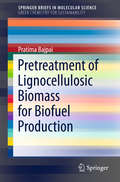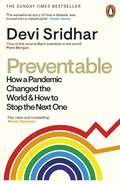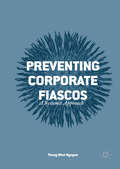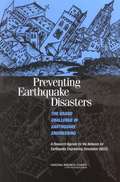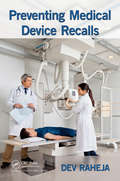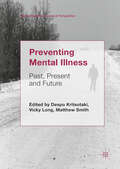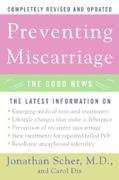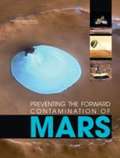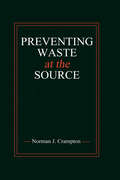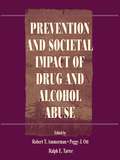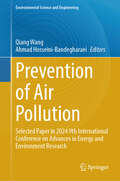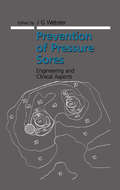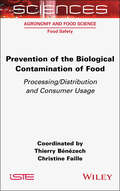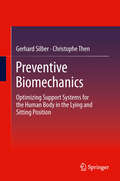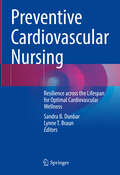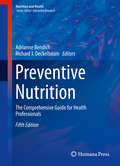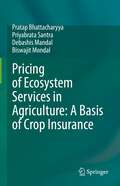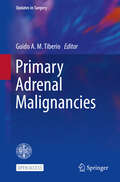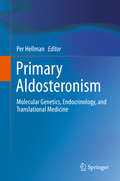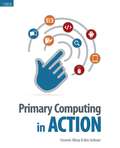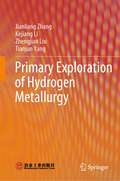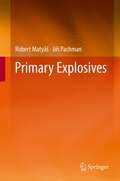- Table View
- List View
Pretreatment of Lignocellulosic Biomass for Biofuel Production
by Pratima BajpaiThe book describes the pretreatment of lignocellulosic biomassfor biomass-to-biofuel conversion processes, which is an important step inincreasing ethanol production for biofuels. It also highlights the mainchallenges and suggests possible ways to make these technologies feasible for the biofuel industry. Thebiological conversion of cellulosic biomass into bioethanol is based on thechemical and biological breakdown of biomass into aqueous sugars, for exampleusing hydrolytic enzymes. The fermentable sugars can then be further processedinto ethanol or other advanced biofuels. Pretreatment is required to break downthe lignin structure and disrupt the crystalline structure of cellulose so thatthe acids or enzymes can easily access and hydrolyze the cellulose. Pre-treatment can be the most expensive process in converting biomass to fuel,but there is great potential for improving the efficiency and lowering coststhrough further research and development. This book is aimed at academics andindustrial practitioners who are interested in the higher production of ethanolfor biofuels.
Preventable: How a Pandemic Changed the World & How to Stop the Next One
by Devi Sridhar**THE SUNDAY TIMES BESTSELLER | BBC RADIO 4 BOOK OF THE WEEK**The definitive story of COVID-19 and how global politics shape our health - from a world-leading expert and the pandemic's go-to science communicator Professor Devi Sridhar has risen to prominence for her vital roles in communicating science to the public and speaking truth to power. In Preventable she highlights lessons learned from outbreaks past and present in a narrative that traces the COVID-19 pandemic - including her personal experience as a scientist - and sets out a vision for how we can better protect ourselves from the inevitable health crises to come.In gripping and heartfelt prose, Sridhar exposes the varied realities of those affected and puts you in the room with key decision makers at crucial moments. She vibrantly conveys the twists and turns of a plot that saw: deadlier varients emerge (contrary to the predictions of social media pundits who argued it would mutate to a milder form); countries with weak health systems like Senegal and Vietnam fare better than countries like the US and UK (which were consistently ranked as the most prepared); and the quickest development of game-changing vaccines in history (and their unfair distribution)Combining science, politics, ethics and economics, this definitive book dissects the global structures that determine our fate, and reveals the deep-seated economic and social inequalities at their heart - it will challenge, outrage and inspire.'A brutally compelling reminder that if voices like Devi's had been listened to, so many more could have lived' OWEN JONES'One of the most brilliant scientists in the world who has been proven consistently right in this crisis' PIERS MORGAN'Excellent . . . Fair, clear and compelling' NICOLA STURGEON'Those who have found Professor Devi Sridhar's expertise and calm advice invaluable since the arrival of Covid-19 will be glad to know that she has written Preventable' RACHEL COOKE, Guardian, Non-fiction to look out for in 2022
Preventing Corporate Fiascos
by Thang Nhut NguyenThe lasting effects of corporate fiascos on business and the economy have spurred investigations, panel discussions, and research in an attempt to find out why these events happen and ways to prevent them. Through case studies and analysis of bankruptcy and institutional collapse, Preventing Corporate Fiascos examines the root cause of these disasters and offers a management exceptions system that diagnoses potential failure from the start. Dr. Nguyen's unique framework is inspired by the biological spectrum, using cancer and disease as a metaphor for prevention and destruction. He uses a proven management repertory grid technique to evaluate aberrant and emotionally-charged decisions which could bring an institution to collapse. By recognizing the institution, its employees, the market and the economy as components of the biological spectrum, we can identify aggravating failure and disease and begin to take effective steps toward prevention.
Preventing Earthquake Disasters: The Grand Challenge in Earthquake Engineering -- A Research Agenda for the Network for Earthquake Engineering Simulation
by Committee to Develop a Long-Term Research Agenda for the Network for Earthquake Engineering SimulationThe Network for Earthquake Engineering Simulation (NEES), administered by the National Science Foundation (NSF), is scheduled to become operational in 2004. These network sites will perform a range of experiments to test and validate complex computer models being developed to simulate the behavior of structures subjected to earthquakes. To assist in this effort, the NSF requested the National Research Council(NRC) to frame the major questions to be addressed by and to develop a long-term research agenda for NEES. Preventing Earthquake Disasters presents an overview of the grand challenge including six critical research problems making up that challenge. The report also provides an assessment of earthquake engineering research issues and the role of information technology in that research effort, and a research plan for NEES.
Preventing Medical Device Recalls
by Dev RahejaA critical and often overlooked aspect of preventing medical device recalls is the ability to implement systems thinking. Although systems thinking won‘t prevent every mistake, it remains one of the most effective tools for evaluating hidden risks and discovering robust solutions for eliminating those risks.Based on the author‘s extensive experienc
Preventing Mental Illness: Past, Present and Future (Mental Health in Historical Perspective)
by Matthew Smith Vicky Long Despo KritsotakiThis book provides an overview of a diverse array of preventive strategies relating to mental illness, and identifies their achievements and shortcomings. The chapters in this collection illustrate how researchers, clinicians and policy makers drew inspiration from divergent fields of knowledge and practice: from eugenics, genetics and medication to mental hygiene, child guidance, social welfare, public health and education; from risk management to radical and social psychiatry, architectural design and environmental psychology. It highlights the shifting patterns of biological, social and psychodynamic models, while adopting a gender perspective and considering professional developments as well as changing social and legal contexts, including deinstitutionalisation and social movements. Through vigorous research, the contributors demonstrate that preventive approaches to mental health have a long history, and point to the conclusion that it might well be possible to learn from such historical attempts. The book also explores which of these approaches are worth considering in future and which are best confined to the past. Within this context, the book aims at stoking and informing debate and conversation about how to prevent mental illness and improve mental health in the years to come.Chapters 3, 10, and 12 of this book are available open access under a CC BY 4.0 license at link.springer.com
Preventing Miscarriage: the Good News
by Jonathan Scher Carol DixA Reassuring and Informative Guide That Offers New Hope For Expectant Parents Along with inspiring accounts of women who have delivered healthy babies after years of heartbreak. Dr. Jonathan Scher provides the latest medical information on preventing recurrent miscarriages, including why couples with "unexplained infertility" actually may be suffering repeat pregnancy loss due to failure of the embryo to implant in the womb, important immunological and tissue tests that may explain or prevent miscarriage, emerging treatments such as heparin and I.V.I.G., updated resources, and much more.
Preventing The Forward Contamination Of Mars
by National Research Council of the National AcademiesRecent spacecraft and robotic probes to Mars have yielded data that are changing our understanding significantly about the possibility of existing or past life on that planet. Coupled with advances in biology and life-detection techniques, these developments place increasing importance on the need to protect Mars from contamination by Earth-borne organisms. To help with this effort, NASA requested that the NRC examine existing planetary protection measures for Mars and recommend changes and further research to improve such measures. This report discusses policies, requirements, and techniques to protect Mars from organisms originating on Earth that could interfere with scientific investigations. It provides recommendations on cleanliness and biological burden levels of Mars-bound spacecraft, methods to reach those levels, and research to reduce uncertainties in preventing forward contamination of Mars.
Preventing Waste at the Source
by Norman J. CramptonAfter a day's work is finished, take a look around at your company. Do standard production processes and day-to-day operations leave you with loaded trash bins from the front office to the factory floor-and every place inbetween?Such "solid waste" does far more than squander resources and imperil the environment... it's undoubtedly eating up countless dollars of your profits.Corporations throughout the nation are learning to tame solid waste, by implementing improved management of materials. Preventing Waste at the Source demonstrates how more than 50 companies have effectively reduced solid waste throughout all departments-and achieved dramatic reductions in operating costs.Beginning with a strategic framework, readers can then zero in on wasteful practices affecting all aspects of a business. Paper reduction measures for administrative offices, for instance. Ways to minimize packing materials over in the shipping department, while still protecting the product. There's also steps where suppliers and customers can take part in waste minimization efforts. Case histories prove it can be done, to everyone's advantage.Researched and compiled by the Indiana Institute on Recycling, Preventing Waste at the Source offers practical, on-the-job assistance to environmental managers, plant managers, manufacturing and quality engineers. Put its techniques and real-life guidance to work. You'll save more than money: you'll help save the environment.
Prevention and Societal Impact of Drug and Alcohol Abuse
by Robert T. Ammerman Peggy J. Ott Ralph E. TarterIt is generally acknowledged that the most cost-effective means of curtailing alcohol and drug abuse is prevention. Providing interventions to at-risk individuals before they develop serious problems with substance use is the most important component of the "war on drugs." Fortunately, the past decade has seen a dramatic increase in the quantity and quality of scientific research on those areas crucial to the advancement of prevention science. This book compiles a tremendous amount of information about prevention which has accumulated in recent years. Documenting these accomplishments and setting the stage for future efforts comprise the focus of this book. Prevention and Societal Impact of Drug and Alcohol Abuse is divided into four parts. Part I contains introductory chapters addressing current issues in prevention science and characteristics of abusable substances. Part II includes chapters on the historical contexts of substance abuse and the deleterious health consequences of alcohol and other drugs. Part III focuses on the impact of drug and alcohol abuse on society. Included are chapters on alcohol and drug abuse and driving, infectious illness, disability, managed care, the criminal justice system and adolescents and adults, sale and distribution, the media, and community responses. Part IV consists of chapters on prevention in specific settings and with certain populations.
Prevention of Air Pollution: Selected Paper in 2024 9th International Conference on Advances in Energy and Environment Research (Environmental Science and Engineering)
by Qiang Wang Ahmad Hosseini-BandegharaeiThis book offers readers with analysis of the main causes and purification technology of air pollution.Air, as the primary element on which human life depends, directly impacts human living and health. However, a 2022 report from the World Health Organization indicated that "the air nearly the entire global population (99%) breathes exceeds WHO air quality limits, threatening their health". Currently, the main approaches to air pollution involve source control and the treatment of air pollutants.Analyzing the causes of air pollution is an effective method for controlling pollution from its source and preventing its spread. It is also an efficient and rapid way to identify harmful gas components and then apply targeted treatment.Currently, big data model analysis and sensor perception technology are widely used analytical techniques. Combined with chemical transport models, they can simulate and predict pollutants, achieving better causal analysis and forecasting.Additionally, air pollution purification is an important component of prevention of air pollution.Currently, the most important research direction is how to purify air pollution without causing secondary environmental contamination, in addition to physical and chemical means.This book provides engineers and researchers in the field of air pollution prevention with research findings related to this area. It aims to share specific and valuable knowledge and content to improve prevention of air pollution efforts.
Prevention of Pressure Sores: Engineering and Clinical Aspects
by J.G WebsterPrevention of Pressure Sores: Engineering and Clinical Aspects collects together material from throughout the literature. The book first discusses the causes of pressure sores and then describes warning signs and behavior to prevent the incidence of pressure sores. It also examines the numerous different devices used to alleviate and prevent pressure sores, including various types of seat cushions, hospital beds, complex pressure relief methods, wheelchair pressure reliefs, and other preventative methods. After comparing the accuracy of various methods of measuring pressure distributions using different types of sensors, the book discusses the treatment of pressure sores. It contains a large number of references, allowing readers to refer back to the important original work in the different fields of this subject.
Prevention of the Biological Contamination of Food: Processing/Distribution and Consumer Usage
by Thierry Bénézech Christine FailleThis book deals with risk management by focusing on microbiological risks. Throughout the food chain, foodstuff may be exposed to dangerous agents that can potentially affect its quality and thus the health of consumers. A good knowledge of the strategies and means of control implemented along the food chain after the primary production stage is a necessary condition and a prerequisite for any further improvement, but it is not sufficient. Indeed, in order to better prevent and therefore control these risks, it is essential to study both the phenomena of surface contamination and those relating to the elimination of this contamination by cleaning and disinfection operations in order to know the main mechanisms. Thanks to this, a certain number of innovations can already be proposed (new surfaces, new materials and cleaning and disinfection procedures, etc.) for future developments on an industrial or domestic scale.
Preventive Biomechanics
by Christophe Then Gerhard SilberHow can we optimize a bedridden patient's mattress? How can we make a passenger seat on a long distance flight or ride more comfortable? What qualities should a runner's shoes have? To objectively address such questions using engineering and scientific methods, adequate virtual human body models for use in computer simulation of loading scenarios are required. The authors have developed a novel method incorporating subject studies, magnetic resonance imaging, 3D-CAD-reconstruction, continuum mechanics, material theory and the finite element method. The focus is laid upon the mechanical in vivo-characterization of human soft tissue, which is indispensable for simulating its mechanical interaction with, for example, medical bedding or automotive and airplane seating systems. Using the examples of arbitrary body support systems, the presented approach provides visual insight into simulated internal mechanical body tissue stress and strain, with the goal of biomechanical optimization of body support systems. This book is intended for engineers, manufacturers and physicians and also provides students with guidance in solving problems related to support system optimization.
Preventive Cardiovascular Nursing: Resilience across the Lifespan for Optimal Cardiovascular Wellness
by Sandra B. Dunbar Lynne T. BraunThis book provides a comprehensive overview of essential concepts and evidence that guide the practice of contemporary preventive cardiovascular nursing. The sections incorporate a lifespan approach to cardiovascular wellness, and provide perspectives on sources of known and emerging cardiovascular risk factors as well as the spectrum of multidimensional factors including biological, behavioral, psychological and sociocultural influences on cardiovascular wellness, risk, and the evolution of cardiovascular conditions. Unique features address: 1) building resilience across the lifespan such that optimal cardiovascular wellness can be attained within multiple contexts of health states to increase a healthy lifespan and longevity; 2) behavior change skills for risk factor reduction; 3) risk factors and risk reduction approaches with special populations defined by gender, , age and aging, heath states, and health equity issues; and 4) high level roles for cardiovascular nurses as provider - risk assessor, communicator and care provider; educator, leader, patient and health advocate. Relevant case studies are included throughout to facilitate the application of the content. This book fills a gap in that there is no other book on preventive cardiovascular nursing care and roles , and it provides support for the nurse to lead relevant interdisciplinary teams. The book will empower nurses to build knowledge and skills for cardiovascular prevention and to provide leadership for optimal cardiovascular wellness for patients and communities.
Preventive Nutrition
by Richard J. Deckelbaum Adrianne BendichEvidence-based nutritional interventions are now a critical component of preventive medicine, employed in a wide variety of medical scenarios. Preventive Nutrition: A Comprehensive Guide for Health Professionals, Fourth Edition gives health professionals up-to-date, comprehensive reviews that evaluate the dietary practices and interventions that have been shown to reduce disease risk and improve health outcomes. This is the flagship volume for the book series, Nutrition and Health, which has become an essential tool for health professionals. As the state of global health and nutrition have changed much since the publication of the Third Edition, this major revised and expanded Fourth Edition includes newly authored chapters and features analysis of the results of the Women's Health Initiative, the largest intervention study ever undertaken and completed in postmenopausal women. Other new material includes chapters reviewing the evidence concerning econutrition, micronutrients and major cancers, and cognitive function and other mental health areas. Also discussed are the importance of gastric acid secretions, the nutritional effects of current therapies, and the latest information on the biology of obesity and its relationship to Type 2 diabetes. One key new feature of this edition is a chapter on behavioral strategies to help assure compliance with dietary regimes, maximizing the health benefits of preventive nutrition. The authors have created the most comprehensive and up-to-date review of the nutritional strategies available for the prevention of disease and the promotion of health through nutrition. Patients are looking for credible information from their health care providers about a whole range of subjects covered here, including ß-carotene, lycopene, antioxidants, folate, and the myriad of bioactive phytochemicals found in garlic and other foods. With sections on cardiovascular disease, diabetes, and pregnancy among many others, this volume will be of great value to practicing health professionals, including physicians, nutritionists, dentists, pharmacists, dieticians, health educators, policy makers, health economists, regulatory agencies and research investigators. An entire section covers nutrition transitions around the world including Eastern Europe, Latin America and Asia as well as goals for preventive nutrition in developing countries.
Pricing of Ecosystem Services in Agriculture: A Basis of Crop Insurance
by Debashis Mandal Pratap Bhattacharyya Priyabrata Santra Biswajit MondalThe book deals with the pricing of ecosystem services provided by agriculture. All provisioning, regulating, supporting and cultural services are being covered in this title. Chapters in this contributed volume cover topics such as pricing of services from the soil, water, and nutrient management. Quantified monetary values of carbon sequestration and renewable energy applications in agriculture are covered with clear-cut methodologies. This book also links ecosystem service-based pricing with crop insurance. Improving the farmers’ livelihood is the central goal of the agricultural production system throughout the world. Under the climate change context, farms’ produce is now climate-vulnerable and heavily dependent on weather conditions. Moreover, we often neglect the contribution of several positive impacts of agricultural practices on ecosystems and natural resources. Therefore, there is a need to quantify and value these ecosystem services in agriculture. However, valuation and pricing the services in agriculture both tangible and intangible is a challenge. It is necessary to have clear-cut methodologies for pricing ecosystem services of agriculture in terms of net monetary benefits. The ecosystem service-based pricing could be a solid basis for calculating the insurance to farmers in case of occurrence of natural hazard and associated crop damage. This book is of interest to scholars, teachers, researchers, environmental scientists, watershed managers, capacity builders, and policymakers. The book also serves as effective reading material for undergraduate and graduate students of agriculture economics, ecology, agronomy, and environmental sciences. National and international agricultural scientists, policymakers will also find this to be useful.
Primal Wisdom of the Ancients: The Cosmological Plan for Humanity
by Laird ScrantonExamines how the similarities of symbols and wisdom across many cultures point to an ancient civilizing plan and system of ancient instruction • Reveals the shared cosmological knowledge of Dogon and Maori cultures, ancient Egypt, Gobekli Tepe, Vedic India, the pre-Indian Sakti civilization, Buddhism, the Tibetan Bon religion, and the kabbalistic tradition of the Hebrews • Explores symbols and techniques used to frame and preserve instructed knowledge as it was transmitted orally from generation to generation • Explains how this shared ancient knowledge relates to the precessional year and the cycles of time known as the yugas Exploring the mystery of why so many ancient cultures, separated by time and distance, share remarkably similar cosmological philosophies and religious symbolism, Laird Scranton reveals how this shared creation tradition upholds the idea that ancient instruction gave birth to the great civilizations, each of which preserves fragments of the original knowledge. Looking at the many manifestations of this shared cosmological knowledge, including in the Dogon and Maori cultures and in ancient Egypt, Gobekli Tepe, Vedic India, Buddhism, the Tibetan Bon religion, and the kabbalistic tradition of the Hebrews, Scranton explores the thought processes that went into formulating the archetype themes and metaphors of the ancient symbolic system. He examines how commonly shared principles of creational science are reflected in key terms of the ancient languages. He discusses how the primal cosmology also transmitted key components of sacred science, such as sacred geometry, knowledge of material creation, and the nature of a nonmaterial universe--evidence for which lies in the orientation of ancient temples, the drama of initiations and rituals, and countless traditional myths. He analyzes how this shared knowledge relates to the precessional year and the cycles of time known as the yugas. He also explores evidence of the concept of a nonmaterial twin universe to our own--the &“above&” to our &“below&” in the famous alchemical and hermetic maxim. Through his extensive research into the interconnected wisdom of the ancients, Scranton shows that the forgotten instructional tradition at the source of this knowledge was deliberately encoded to survive for countless generations. By piecing it back together, we can discover the ancient plan for guiding humanity forward toward greater enlightenment.
Primary Adrenal Malignancies (Updates in Surgery)
by Guido A. M. TiberioDissemination of knowledge is the best and only strategy capable of improving clinical management in rare and ultra-rare malignancies, including primary adrenal malignancies. It is preliminary to any further healthcare policy such as, for example, the centralization of cases in referral institutions. Adrenal primary malignancies are probably the rarest among rare pathologies. This epidemiological consideration is at the origin of a vicious circle: the lack of preoperative diagnosis leads to inappropriate surgical procedures and to inadequate follow-up and systemic therapy strategies. Furthermore, when malignancy is recognized, the relative role of systemic, surgical, or other local ablative techniques is often misinterpreted. All this produces a negative impact on survival, also in patients who could have been cured with a correct therapeutic strategy. This open access book provides a user-friendly exploration of these rare conditions, using a transversal approach common in modern precision medicine. The text covers various clinical aspects, including epidemiology, genetics, molecular medicine, imaging, and surgery. Guidelines for managing syndromic situations are provided. The book thoroughly addresses all the different surgical issues and emphasizes the importance of pathology in assessing prognosis. The pivotal role of medical oncologists in managing these patients is explored, along with alternative treatments such as nuclear medicine and radiotherapy. Finally, the book highlights the latest preclinical research and its implications for translational medicine.
Primary Aldosteronism
by Per HellmanPrimary Aldosteronism (PA) is a disease caused by the overproduction of aldosterone hormone from the adrenal glands. PA causes hypertension and the majority with this disease are undiagnosed for PA. There are new insights into this matter by using biochemistry as well as advanced radiology. In 2011, a breakthrough in the genetic derangements came, identifying a mutated potassium channel gene - KCNJ5 - in about 40% of PA with adenoma. Chapters in this book include a history of the disorder, epidemiology, genetics derangements, the KCNJ5 mutations and phenotype and more.
Primary Computing in Action
by Ben Sedman Yasemin AllsopPresenting practical ideas that support teachers and trainees with the planning, implementation and assessment of the 2014 Primary Computing Curriculum. Demonstrating how freely available apps and web-based applications, programmes for PCs and Macs, can be used creatively to design innovative and engaging activities in the Early Years, Key Stages 1 and 2. Covering all aspects of the 2014 primary curriculum, including computer science, digital literacy and information technology. Includes both plugged and unplugged activities.
Primary Computing in Action
by Ben Sedman Yasemin AllsopPresenting practical ideas that support teachers and trainees with the planning, implementation and assessment of the 2014 Primary Computing Curriculum. Demonstrating how freely available apps and web-based applications, programmes for PCs and Macs, can be used creatively to design innovative and engaging activities in the Early Years, Key Stages 1 and 2. Covering all aspects of the 2014 primary curriculum, including computer science, digital literacy and information technology. Includes both plugged and unplugged activities.
Primary Exploration of Hydrogen Metallurgy
by Jianliang Zhang Kejiang Li Zhengjian Liu Tianjun YangThis book is a monograph dedicated to hydrogen metallurgy technology in iron ore reduction in the world (mainly in China), aiming to accelerate the development of hydrogen metallurgy research and promote the low-carbon process in the iron and steel industry. This book mainly introduces the frontier theory and process technology of hydrogen metallurgy, focusing on the behavior and role of hydrogen in reducing iron ore. The specific contents include hydrogen production and storage technology, hydrogen direct reduction of iron oxide technology, hydrogen smelting reduction of iron oxide technology, plasma hydrogen reduction of iron oxide theory, and the behavior of hydrogen in blast furnace iron-making and sintering processes. This book provides a comprehensive and detailed description of the theories and process technologies involved in hydrogen metallurgy at the levels of fundamental theory, feasibility analysis, experimental studies, and industrial applications. This book can be usedas a reference for metallurgical engineering, iron, and steel metallurgy majors, as well as teachers and students, researchers, engineers, and enterprise staff interested in hydrogen and low-carbon metallurgy-related fields.
Primary Explosives
by Robert Matyáš Jiří PachmanThis is the first comprehensive overview of this topic. It serves as a single source for information about the properties, preparation, and uses of all relevant primary explosives. The first chapter provides background such as the basics of initiation and differences between requirements on primary explosives used in detonators and igniters. The authors then clarify the influence of physical characteristics on explosive properties, focusing on those properties required for primary explosives. Furthermore, the issue of sensitivity is discussed. All the chapters on particular groups of primary explosives are structured in the same way, including introduction, physical and chemical properties, explosive properties, preparation and documented use. The authors thoroughly verified all data and information. A unique feature of this book are original microscopic images of some explosives.
Primary Science
by John Sharp Graham Peacock Rob Johnsey Debbie WrightThis dictionary has been updated with new headwords, now over 650, makingit more comprehensive. Each entry is in alphabetical order and along with aclear and straightforward definition, has a funky colour illustration or diagramto help explain the meaning. Cross references link the user to other usefulwords in this dictionary so it is easy to build up vocabulary quickly. Thecolourful, modern design and artwork make it easy to pick out the word you need,and fully understand it.
